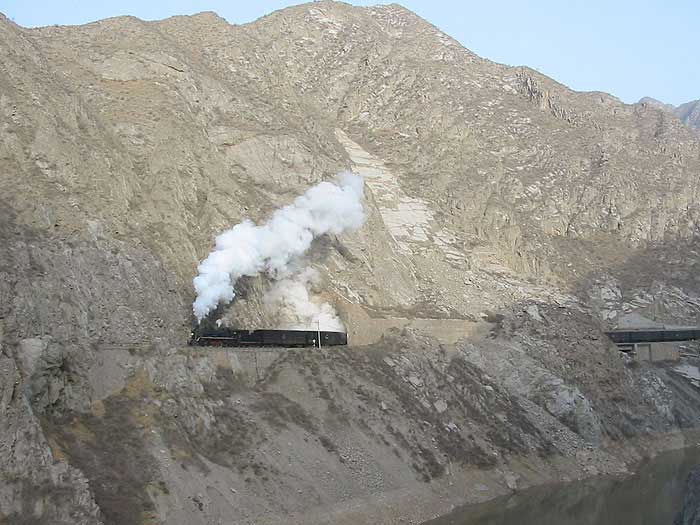

Grandiose mountain landscapes, giant steam exhaust, hard working locomotives from massive 2-10-2s to tiny narrow gauge 0-8-0s, brilliant clear winter sky ... Those who haven't experienced the last great winter steam service in the world still have a chance. But the endgame of the steam empire in China has already started. There won't be a second chance for several steam lines after next winter!
| Date | Supplements | Itinerary |
| 08.1.06 | Departure Europe to Beijing (Peking) | |
| 09.1.06 | Morning arrival in Beijing, charter bus to the steelworks Qian'an (SY), continue by train 1467, departure Fengrun 17.48 hrs, arrival Huludao 21.35 hrs, hotel Huludao | |
| 10.1.06 | Charter bus for linesiding along the limestone railway line of Huludao (JS), evening continue by train N113 to Shenyang, departure Huludao 17.01 hrs, arrival Shenyang 20.45 hrs, charter bus to our hotel in Fushun (about 50 minutes) | |
| 11.1.06 | Visit to the open cast mine Fushun (Japanese pre-revolution electric locos and railcars, SY), hotel Diaobingshan | |
| 12.1.06 | Charter bus for linesiding along the coal mine system of Tiefa (SY), hotel Diaobingshan | |
| 13.1.06 | Tiefa again, overnight train N151/154 from Shenyang, departure 18.55 hrs | |
| 14.1.06 | Arrival in Yuanbaoshan 05.35 hrs, charter bus to the coal mine railway of Yuanbaoshan (JS), hotel Chifeng | |
| 15.1.06 | Visit to the open cast mine Pingzhuang and the small coal mine Malin, in the afternoon we'll go again to Yuanbaoshan, overnight train 2560, departure Chifeng 20.20 hrs | |
| 15.1.06 | Departure Europe to Beijing (Peking) | |
| 16.1.06 | Arrival Beijing Bei 6.14 hrs, brief stop at a hotel for having a shower, meeting the main group arriving from Europe, see below, for connections | |
| 16.1.06 | Morning arrival Peking, brief stop at a hotel for having a shower, continue by overnight train T151, departure Beijing Xi 14.23 hrs | |
| 17.1.06 | 11.09 arrival Lanzhou, charter bus for a brief visit to the fantastic line Liujiaxia - Hekou Nan (JS), pictures of the only daylight train in the gorge of the yellow river, evening continue to Shangchuankou (Minhe), hotel Shangchuankou | |
| 18.1.06 | Visit to the two spectacular mountain railways of Yaojie (SY), hotel Shangchuankou | |
| 19.1.06 | Linesiding around Yaojie, evening continue by overnight train N 902, departure Haishiwan 20.20 hrs | |
| 20.1.06 | 0.08 hrs arrival BaiyinXi, charter bus to Baiyin (10 minutes drive), hotel Baiyin, linesiding north of Baiyin (SY), steam in the loess mountains, hotel Baiyin | |
| 21.1.06 | In the morning linesiding around Baiyin, around noon charter bus to Lanzhou and continue by overnight train 2010, departure Lanzhou 15.55 hrs | |
| 22.1.06 | Arrival Yima 06.40 hrs, Visit to the small open cast mine of Yima (JS), hotel Yima | |
| 23.1.06 | Charter bus to the narrow gauge coal railway of Yinghao (C2), in the evening continue to Xingyang, hotel Xingyang | |
| 24.1.06 | Charter bus to the narrow gauge line of the brickworks Xingyang (C2), in the evening continue to Pingdingshan, hotel Pingdingshan | |
| 25.1.06 | Visit to the lines of the very busy coal mines around Pingdingshan (QJ, JS and SY), charter bus for linesiding | |
| 26.1.06 | Visit to the lines of the coal mines of Pingdingshan, charter bus for linesiding, evening charter bus to Zhangzhou, overnight train K180 to Beijing, departure 22.16 hrs | |
| 27.1.06 | Arrival Beijing Xi at 06.04 hrs, shower and breakfast in a hotel on the way to the airport, return flight to Europe, arrival in the same evening | |
| 27.1.06 | 02.55 hrs (!) arrival in Shijiazhuang, hotel Shijiazhuang near the railway station, visit to the local line of Shijiazhuang (QJ), evening continue to Beijing by train T514, departure 17.58 hrs, arrival Beijing Xi 20.45 hrs, hotel in Beijing | |
| 28.1.06 | Transfer to the airport and return flight to Europe, arrival in the same evening |
The small steelworks Qian'an uses some SY's. Qian'an is one of the few steelworks, which allow visits by foreigners without a large variety of restrictions. We'll visit the furnace blast area as well as the slag tip.
The lime stone railway of Huludao is especially interesting for its mountainous character. Locomotives near the summit slow to pedestrian speed or even stall on the grade. These are very filthy, but picturesque locomotives of the JS class. For shunting purposes in the cement factories they own two SY's. There are three pairs of trains, one in the early morning (best for photography with the train coming out of the light), a pair around noon and one in the late evening. At the terminus in Yangjiazhangzi they have a photogenic turntable.
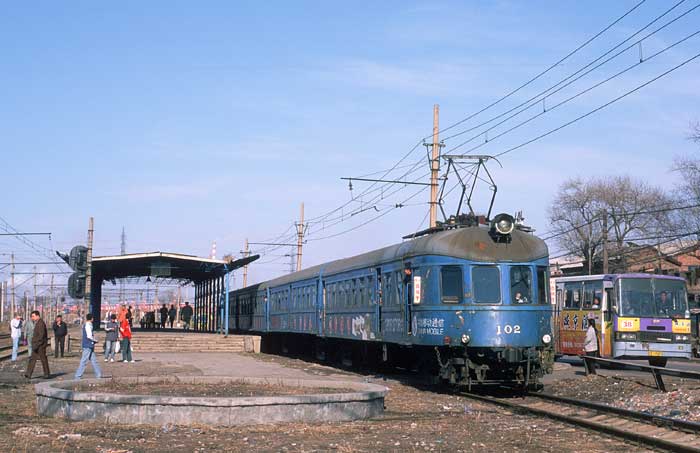
In and around Fushun there are many industries. Some of them are still using steam (class SY). Of special interest are the electric railcars and electric locomotives. Beside modern units, the Fushun coal mine still uses Japanese pre-revolution designs. The railcar reminds the visitor to German-built railcars from the 1930s. For the miners they operate push-pull trains into the open cast mine. Most of them are hauled by the old electric locomotives, and the coaches are as old as the locomotives. Some trains for the transport of workers as well as some works trains are hauled by SY's.
The coal mine system of Tiefa was dieselised in 2004/2005 for freight service. Fortunately all passenger trains remained steam hauled. According to high ranked officials they'll keep their steam locos running for at least another three years. A diesel hauled passenger train would be at least twice as expensive as a steam hauled service. On the four lines there are some 20 steam hauled passenger trains a day, often with several departures within a few minutes of each other. So this system is still worth a visit with some very exciting action and photo locations.
The most scenic part of the system is the line from Diaobingshan (the operational centre) to Faku. Trains pass through a tunnel on this line. As they haven't a turntable nor a wye, locomotives are running tender first in one direction and chimney first the other. It's unpredictable which way will be tender and which one chimney first. A visit to the depot and the stabling point are planned as well. Tiefa's SY's are nicely maintained and include two 1999-built engines.
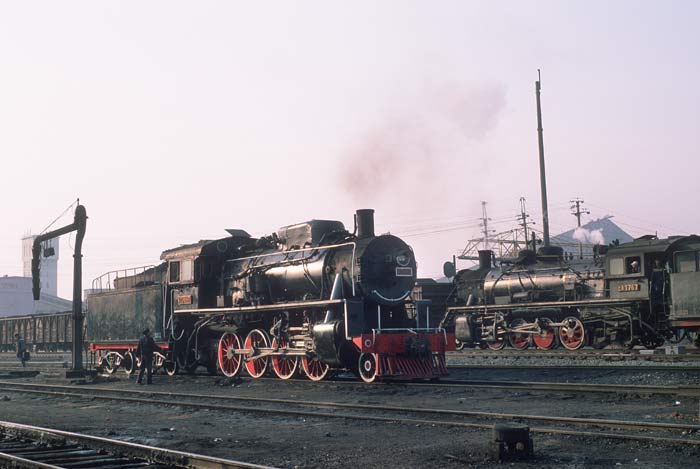
In 2004 Tiefa refurbished a former Pingzhuang based locomotive, the American-built KD6 487 (2-8-0). We've planned to use this loco for a scheduled passenger train instead of a charter train. This will guarantee normal passenger coach stock instead of the museum stock. The museum stock is fine as well, but the wagons are too clean for a coal mine. Of course, we'll get only one or two shots of the KD6 with the scheduled passenger, however, these shots will be more realistic than a short special train can ever be.
In Yuanbaoshan we'll meet some very clean JS class 2-8-2s. These engines carry big smoke deflectors, which makes them exceptionally attractive. The line is not that scenic, but with the mixed train in the afternoon you can make some nice shots, and there are interesting industrial backgrounds. On the line to the northern mines there is a steep gradient (and a cement factory in the backdrop). There is no fixed timetable and the trains are run on demand. Yuanbaoshan is going to be dieselised in 2006, so it is high noon for a visit to this mine system.
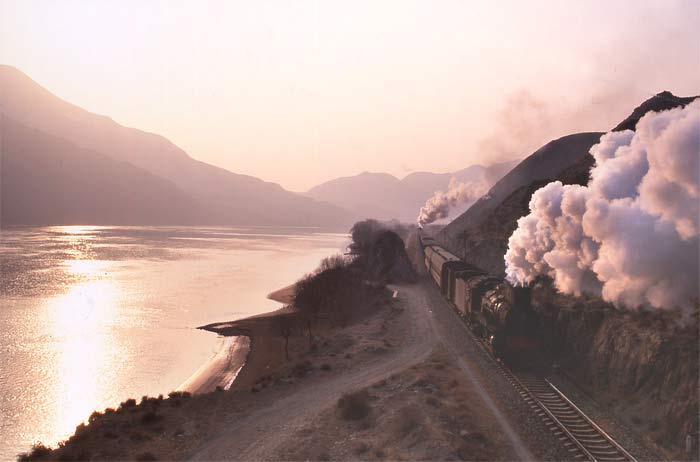
Southwest of Lanzhou, a spectacular branch line leads through the gorge of the Yellow River to Liujiaxia. Unfortunately there is only one train during daylight. This train departs Liujiaxia in the afternoon, tender first. Anyhow, we can make an exiting shot in the gorge of the Yellow River. This position is over the river from the side with a mountain backdrop, so it is not that important that the loco is running tender first. Sometimes the train operates with a banker or pusher engine at the end of the train making photos particularly interesting and dramatic.
Amongst the most remarkable new discoveries of 2004 are the two industrial railways of Yaojie. Yaojie is the starting point of one line to the north, which has average potential and one to the south, which is an exciting mountain railway trough a deep gorge. The traffic is irregular and not frequent, so we planned to stay here for two days. Compared to this line the Jingpeng pass is just a collection of minor hills.
One of the last lines passing through the loess mountains is the industrial line at Baiyin. In part the line is surrounded by mountains and no industrial complex is visible. Beside freight trains, Baiyin offers passenger services. The terminus is a sight which will remind you of the 1970s, with housing blocks for the workers and huts made of bricks surrounding the station. Smog is very common in this industrial city, so we hope for a breeze to blow the pollution away. Anyhow, it is a very atmospheric place.
The open cast mine at Yima has had financial problems for a long time. This is one of the reasons why they are still using the JS class for bringing out the coal. Trains can be run tender first as well as chimney first. The coal mine is smaller than the well known very large operations at Jalai Nuer or Sandaoling. However, it has it's own flair and is very interesting. We hope that the mine will not have gone bankrupt, because this would bring the steam service to an abrupt end.
Yinghao is a busy narrow gauge line that carries coal. Along the line there are many poles and wires. The most scenic parts are the loading and unloading facilities as well as the turning triangle and the line to the depot (some 2 km long). In addition, the steep gradients often require a stop to blow up the steam pressure. Just before the main station there is a short tunnel. The cutting in front of the tunnel is another good spot for both photography and video. Last but least, is the depot itself. Here the engines get everything from running repairs to heavy overhauls. The full site looks like a big repair shop which is working under military field conditions. It's full of dumped locos, spare parts and scrap. In dark halls, illuminated by dim, yellow lamps, workers are carrying out repairs and maintenance on the rolling stock. This depot makes a deep impression on every foreign visitor.
Xingyang has a short industrial narrow gauge railway with steam service. The line passes an interesting area with huge, deeply eroded valleys. The best possible shot is an arch bridge made of brick and stones which crosses over a small lake. This means many good possible shots, if the railway is working. The railway supplies clay to a brickworks in Xingyang. The railway doesn't work every day but if it does, we have the chance to see six pairs of trains. Otherwise we'll go to another site with steam traction nearby.
Pingdingshan is the only known coal mine which uses all three main classes of Chinese steam locomotives: SY, JS and QJ. Fortunately, the dieselisation which was feared to be competed in 2006 so far has only produced a single diesel locomotive. The repair shop is continuing to overhaul steam locomotives, so the chances are still very good to see many of them in action during the winter of 2006.
The network of lines offers all: rural scenes, steep gradients, industrial backdrops and large shunting yards. Usually in the morning and in the afternoon traffic levels are quite good, while during the rest of the day it can be a gamble to find out which line will be served by a steam train next. Double headed trains and even triple traction (one banker) are common. Passenger trains give you the chance to see at least one train on each line.
The local railway of Shijiazhuang uses the mighty QJ-locomotives and the line has a beautiful part making a visit very worthwhile. Unfortunately this part in not easily accessible and photography can be challenging. The density of trains varies between no trains and three trains a day. Railway workers here are not always helpful, so to get information about the schedule can be impossible. A visit to the depot is off limits, here it's still a secret apparently. The only way to get shots is: arrive, enter, take shots and disappear as soon as possible. This method was successful in many places before, so it is an option to try it this way. Official permits are not available.
On this trip we will cover long distances by rail. The scheduled domestic flights often did not save time in the long run, so we decided to use the safe and convenient way of transport: soft sleeper accommodation on long distance express trains.
On the northern part of our trip we expect morning temperatures around minus 20 degrees Centigrade while in Pingdingshan the mercury can raise above zero. So you shouldn't forget warm winter clothes as well as batteries that are resistant to sub-zero temperatures (Lithium batteries or Lithium-Ion rechargeable are best). The voltage in China is 220 Volts, 50 Hertz. Sometimes you need an adapter for the power outlets. China uses the European mobile phone (GSM) standard.
This tour is designed for both dedicated photographers and video filmmakers. Our philosophy is to provide opportunities to get that perfect sunrise shot rather than a time consuming 5-star breakfast buffet. On occasions lunch will be served as a packed meal. Alcoholic beverages are not included in the tour price.
Hotels, charter buses and trains represent the standard of our host country, which may deviate from European expectations. While we will endeavour to avoid long walks, some photo positions may require an extra but worthwhile effort.
The hotels used will be of medium class, but in remote areas sometimes they are more basic. The train rides are booked in soft sleeper class (four berth compartments). As the reservation system in China is a typical quota system where the station of origin typically gets an allotment of 50 % of the available tickets, it is not guaranteed that we can get soft sleeper tickets for all our rides. In such cases we'll use hard sleeper class, which, however, is not as hard as the name suggests. Hard sleeper compartments are open and normally comprise six berths. Short daytime trains may have to be booked in hard seater class. Hygienic and environmental standards in China often do no conform to European expectations. Carrying some toiletries in your photo bag is hence advisable.
Please bear in mind that accommodation and transportation in China fall short of EU safety standards. Always use common sense when crossing roads and railway tracks. Farrail Tours cannot be held responsible and will not accept any liability whatsoever in the case of any accident or damage. We suggest you take out a comprehensive overseas accident and health insurance policy.
Later registrations will be accepted if flights and hotels are still available. If you're not sure whether you can participate or not, please let us know your interest well in advance so that we can hold a place for you.
Please note that for simplicity, tips are already included in the tour price.
| China: The Great Winter Spectacle | 11 and more participants | 2.260 Euro |
| 15.01. to 27.01.2006 | 6 to 10 participants | 2.390 Euro |
| Single room surcharge | 190 Euro | |
| Pre-program | 6 and more participants | 995 Euro |
| 08.01. to 16.01.2006 | Single room surcharge | 120 Euro |
| Shijiazhuang-extension | 6 and more participants | 136 Euro |
| 27.01. to 28.01.2006 | Single room surcharge | 22 Euro |
| Complete Winter tour | 11 and more participants | 3.320 Euro |
| 15.01. to 28.01.2006 | 6 to 10 participants | 3.460 Euro |
| Single room surcharge | 332 Euro |
The pre-program cost is for the land-only parts. It was developed to be combined with the main tour that includes the costs of the Europe – Beijing return flights.
Minimum number of participants 6
Maximum number of participants: 28
The price includes:
Not included are:
Above prices are based on specific bookings with the respective airlines, which have to be confirmed well in advance. Your early booking is hence essential.
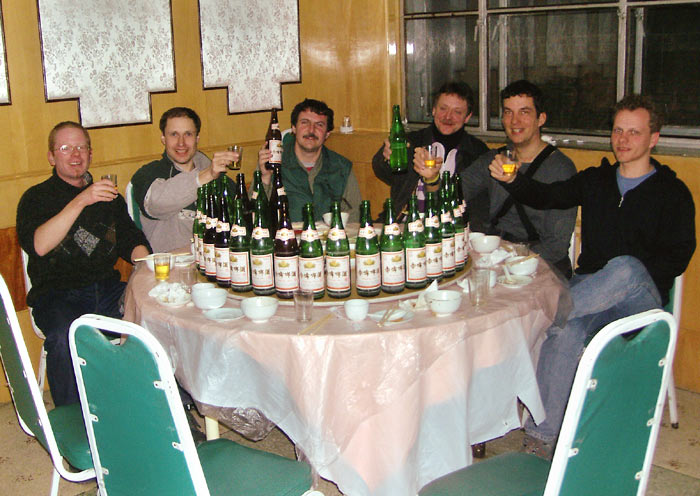
© FarRail Tours - e-mail: Bernd Seiler - zurück zu FarRail Tours
Click here to return to FarRail Tours